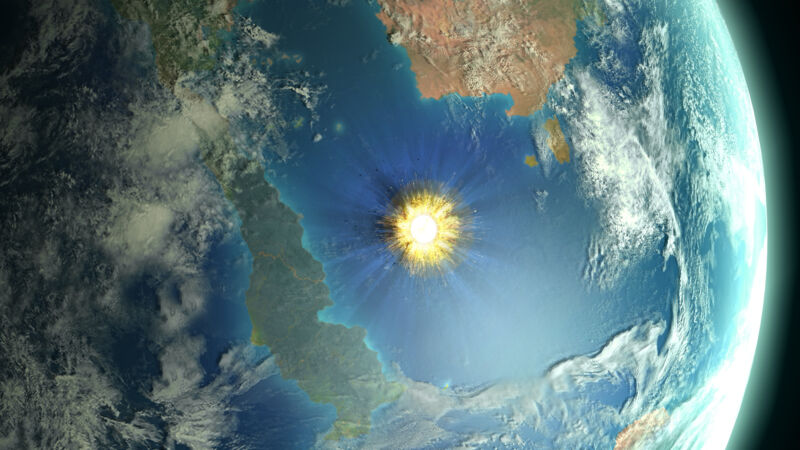Classic whodunit mysteries work because just about every character ends up being a murder suspect. The demise of non-avian dinosaurs is a lot like that. The Chicxulub impact and its aftereffects created a huge range of potentially lethal suspects. Whodunit? A giant fireball and massive tsunamis? Wild swings in the climate? Global wildfires? A blackened sky that shut down photosynthesis? All of the above?
Modeling these impacts, combined with data on the pattern of extinctions, has led to various opinions on what proved decisive regarding the extermination of so many species. In the latest look at the end-Cretaceous extinction, a team of scientists largely based in Brussels has revisited deposits laid down in the aftermath of the impact and found that much of the debris came from fine dust. When that dust is plugged into climate models, global temperatures plunge by as much as 25° C, and photosynthesis shuts down for almost two years.
Dust to dust
There was a lot going on in the atmosphere in the years after the impact. Debris thrown up by the impact would have re-entered Earth's atmosphere, burning up into fine rocky and sulfur-rich particles in the process. The heat generated by this process would have set off massive wildfires, adding a lot of soot to the mix. And all of that was churned up with the debris from the impact that stayed within the atmosphere.
This has led to the idea of an "impact winter," where little sunlight made it to Earth, leading to a dramatic drop in temperature and potentially a shutdown of photosynthesis. All three of the main components of the dust in the atmosphere—soot, rocky debris, and sulfur-rich particles—have been blamed, but modeling has raised questions of whether any was present at sufficient levels to cause an impact winter.
To get a better sense of what's going on, the researchers behind this new paper revisited the deposits at a site called Tanis in North Dakota, where tsunami debris swept ashore in the immediate aftermath of the impact. Also present: shocked quartz crystals that would have arrived at the site directly from the impact in a matter of hours. Above all those layers of impact debris resides an iridium-rich layer of dust that is largely composed of silicate materials that were blasted out of the site of the impact and gradually settled over the ensuing few years.
The researchers scanned this layer with a laser diffraction imager, which allowed them to estimate the size of the dust particles that formed these deposits. The average particle size turned out to be considerably smaller than the one that most research had assumed was produced by the impact. This smaller size will have an impact on how long the dust stays in the atmosphere, as well as how it interacts with sunlight.
To understand how that might influence the events following the Chicxulub impact, the researchers plugged it into a global climate model.
The big chill
The researchers let the model reach a steady state for the end-Cretaceous continental configuration and atmospheric composition. Depending on the season, this produced global temperatures between 15° and 19° C. They then injected a lot of stuff into that atmosphere, based on estimates generated elsewhere: 1018 grams of silicate dust, 1016 grams of soot, and 1017 grams of sulfur dioxide. They also ran simulations with each of these impact debris individually for comparison.
The effects were dramatic. The most extreme runs of the climate model saw temperatures drop by as much as 25° C. Conditions remained "severe" for at least five years, and temperatures remained below the pre-impact conditions for about 20 years in total.
Each type of material has a distinct half-life in the atmosphere and interacts in different ways with light—both incoming sunlight and infrared radiation traveling from Earth to space. As a result, the impact of the mixture of them is distinct from the effect of any single type of particle in the atmosphere. And the finer grains of dust used in this work stayed in the atmosphere over twice as long as the coarser dust explored in earlier modeling.
In addition to the radical change in climate, the researchers estimate that it takes less than two weeks after the impact for photosynthesis to shut down globally. It stays off globally for at least 1.7 years when a partial return happens during the Southern Hemisphere's summer. (That's consistent with extinctions being more severe in the Northern Hemisphere.) Photosynthesis remained suppressed for as long as four years after the impact.
The results help make it clear why solving scientific whodunits can be so challenging. It only took a slight change in the size of particles blasted aloft at Chicxulub to dramatically change the climate dynamics for years following. Hopefully, over time, data from other sites will help us sort through the complicated events that came after the impact.
Nature Geoscience, 2023. DOI: 10.1038/s41561-023-01290-4 (About DOIs).



3175x175(CURRENT).thumb.jpg.b05acc060982b36f5891ba728e6d953c.jpg)
Recommended Comments
There are no comments to display.
Join the conversation
You can post now and register later. If you have an account, sign in now to post with your account.
Note: Your post will require moderator approval before it will be visible.